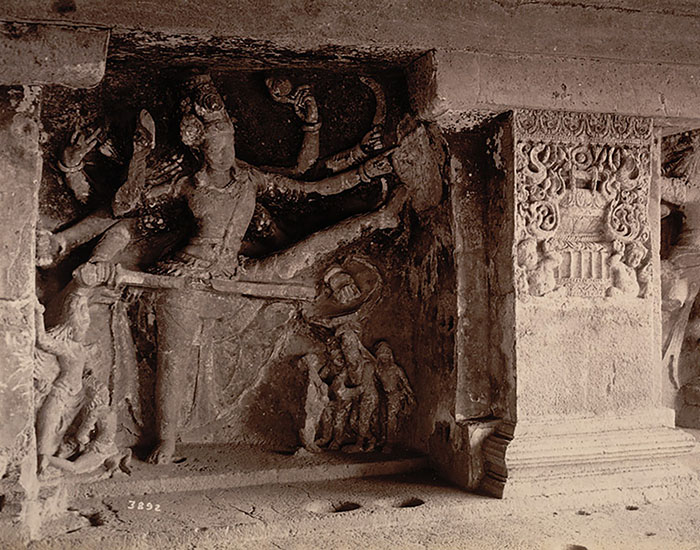Encyclopedia of Art > Articles
Dashavatara Cave, Ellora

A Shaivite shrine in the Ellora cave temple complex, the Dashavatara Cave, also known as Cave 15, marks a late phase of cave architecture in Ellora. It is the only cave in the complex which bears an inscription both dating it and linking it to royal patronage, specifically that of the Rashtrakutas. Scholars have used this to argue that the Rashtrakuta king Dantidurga ordered the excavation of the cave to commemorate his conquest of the Ellora region in the mid-eighth century CE.
Like most caves at the Ellora complex, the Dashavatara cave is carved out of a single cliff face. It is one of the few caves to feature an external freestanding mandapa, carved out of the same rock; the sculptural niches on this structure are surmounted by gavakshas, unlike the kuta and panjara pavilions more commonly seen in contemporary Deccan temples. This freestanding mandapa may be a predecessor to the more ambitious freestanding excavations seen in the later Kailasanatha temple.
The cave proper is two storeys tall; the upper storey consists of a mahamandapa containing forty-two ornamented pillars in six rows, with large sculptural niches along the northern and southern walls. An antechamber, leading to a garbhagriha containing a Shiva linga, is carved into the eastern wall; it is flanked by two sculptural niches on either side. The deep court of the mahamandapa is a distinctive feature of later caves at Ellora. The ground level is supported by fourteen plain pillars and a number of cells, features similar to those of the Buddhist Caves 11 and 12 in the Ellora complex; seated Buddhas are also depicted on the bracket-capitals of the upper storey. This has led several scholars to suggest that the Dashavatara cave was initially excavated as a Buddhist shrine, being converted into a Shaivite shrine before its completion by the Rashtrakutas.
The upper storey incorporates six large relief carvings featuring Vishnu and four featuring his avatars, thus earning the name “Dashavatara” in the centuries after its excavation. The bas-reliefs in the cave also depict deities such as Ganesha, Surya, Shiva, Parvati, and Ardhanarishvara. The sculptures on the north side are mostly Vaishnava, while entirely Shaiva on the south and east. The narratives depicted in these sculptural panels are usually the climax of legends, focusing on heightened action.
The sculptures in the Dashavatara cave usually depict multi-armed deities in dynamic poses, with exaggerated, expressive hands, faces, and feet. The vertical compositional principle favoured in earlier caves at Ellora and at contemporary Deccan temple sites such as Pattadakal is replaced with an emphasis on the diagonal. This can be seen in the Shiva Dancing in Lalita and the Narasimha-Hiranyakashipu panels, where the gods’ bodies and arms are positioned around diagonal axes, imparting a sense of movement and energy to the sculptures. The volume of the sculptures is variable and fluid; some panels are carved within deep cavities, giving a sense of envelopment by negative space and heightening their dramatic impact.
The Dashavatara’s inscription and sculptural features have led some scholars to suggest that it is a crucial landmark in the history of the Ellora cave complex. It continues to remain a major tourist attraction as of writing.
First Published: April 21, 2022
Last Updated: July 26, 2023

